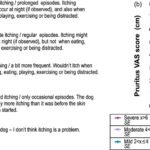What is a mast cell tumour?
These tumours appear as a raised lump or bump on the dog’s skin, or just under it. It can look red, swollen, ulcerated and nasty looking. They can grow a varying rates – sometimes doing nothing for months, and other times appearing to change size overnight. The area around the tumour is also swollen and angry looking.
These nodules can also appear in other areas of the body including spleen, intestines, and in the bones. But mast cell tumours are the most common tumour in dogs – and most dogs have only ONE tumour.
What causes mast cell tumours?
As usual with modern medicine, everyone claims to not know what causes the most common problems. There is the usual dodgery that talks about “genetic mutations” or a combination of environmental and genetic factors, or some “mechanism” that sounds technical but means nothing of consequence.
What do we actually know about mast cell tumours?
Any breed of dog can get them. but some breeds get them more often. This includes boxers, terriers and labrador retrievers.
We do know that “mast cell degranulation” occurs – which just means that the dog’s mast cells release “granules” of very inflammatory chemicals. The “activation” of this granulation happens when something triggers the dog’s immune system (called an “allergen”, seriously!). A variety of inflammatory chemicals are released from mast cells. You will recognize one being histamine – just like when you get hay fever. But there are a stack of other chemicals released – and the word “toxin” is probably a better term than “allergen” – “trigger” is also a good term as mast cells can be triggered by things other than “allergens”.
Treatment?
Most vets go for surgery, although with complex tumours chemotherapy is often combined with surgery.
Other than that the main relief meds are from “anti-histamines” to help with the itch, inflammation and swelling caused by the chemicals releasted from mast cells (histamines, leukotrienes, interleukin, etc).
This is where PEA (palmitoylethanolamide) may be useful. This study from 2010 talks about the effect of PEA on inflammatory chemicals released by mast cells in your dog (and in you if you have allergies!). Effects of palmitoylethanolamide on immunologically induced histamine, PGD2 and TNFalpha release from canine skin mast cells.
These studies can be hard to read, but often are worth the struggle to understand the terminology.
1. “PEA has been proven to exert both analgesic and anti-inflammatory activity, and recent studies have shown its ability in reducing clinical symptoms of inflammatory skin diseases, both in humans and in animals.”
2. “Histamine, prostaglandin D(2) (PGD(2)) and tumour necrosis factor-alpha (TNFalpha) release was measured in the presence and absence of increasing concentrations of PEA, ranging from 10(-8)M to 10(-5)M. Histamine, PGD(2) and TNFalpha release, immunologically induced by canine anti-IgE, were significantly inhibited in the presence of PEA.”
3. “Conclusion: The results obtained in the present study showed the ability of the aliamide PEA to down-modulate skin mast cell activation. Therefore, our findings suggest that the beneficial effect of PEA, observed in inflammation and pain clinical studies, could be due, at least in part, to its ability to inhibit the release of both preformed and newly synthesised mast cell mediators.”
https://pubmed.ncbi.nlm.nih.gov/19625089/
In simple terms:
- PEA has both a pain-relieving and an anti-inflammatory effect, and can reduce the symptoms of inflammatory skin conditions.
- PEA INHIBITED (significantly) the nasty chemical released by mast cells.
- Concludes that PEA mediates (“turns them down”) mast cell activation.
Was this study a fluke?
Well, no. There is plenty of data about the effects of PEA on mast cell activation. This one (Palmitoylethanolamide counteracts substance P-induced mast cell activation in vitro by stimulating diacylglycerol lipase activity) from 2019 is also very clear. This study was done on rat leukemia basal cells that also cause mast cells to pump out these inflammatory chemicals. (They gave the rats leukemia to get the cells to work with.)
They “triggered” the rat cells with “Substance P” (P for pain!) to both increase the number of mast cells and to cause them to release a ton of histamine type chemicals. There are other interesting biochemical and genetic effects present in this study – but for you and your dog with a mast cell tumour, the key is that PEA both reduces the increase in number of mast cells and also reduces the release of histamines and other nasty chemicals from them.
So – consider getting from PEA for your dog (or other animal). Feel free to contact me with questions as this is not a simple situation. But the evidence suggests it is very probable that PEA will help your dog.
Extra Info About Mast Cell Tumours (Opinion!)
Over the past couple of decades there has been a trend in medicine to attempt bring medical conditions into a “single cause” definition. And it has failed. Unless there is a clear “lock and key” pathway for a single thing to be the cause of a condition – the condition’s cause is claimed as “unknown”. This tumour fits this exactly. Your vet will not tell you what causes these tumours, although some will guess and say “too much Sun” or “this breed just gets them”.
I believe that there are too many systems for anyone to be able to “solve” a condition without using a systems approach. (They use a “reductionist” approach – which means they attempt to figure it out by reducing the number variables. )
Anyway – if you can work the internet and figure out the terminology used in the millions of studies that have been completed – you can become your own sleuth. Here is some grit to begin with:
From 2017 The Roles of Mast Cells in Parasitic Protozoan Infections we can learn a lot about mast cells and what causes them to “activate” and to “granulate”.
I will give you chunks from this paper, and then a translation.
“Protozoan parasites such as Plasmodium spp., Leishmania spp., Trypanosoma spp., and Toxoplasma gondii are major causes of parasitic diseases in both humans and animals.” Protozoans are creatures that are not bacteria or viruses. (Eg malaria is caused by a protozoan)
“investigate the function of immune cells involved in the process of parasite infections and the responses of host immune system to parasite infections. Mast cells (MCs) are known to be central players in allergy and anaphylaxis, and it has been demonstrated that MCs have crucial roles in host defense against a number of different pathogens, including parasites.” Mast cells are part of the immune response to parasites.
“Herein, we review the current knowledge about the roles of MCs and their mediators during infections involving highly pathogenic protozoa including Plasmodium spp., Leishmania spp., Trypanosoma spp., and T. gondii. ” This paper reviews the role of MCs (Mast Cells) and what happens when there is a protozoa infections with 4 different bugs.
The paper then gets very technical, read it if you want.
Last bit! “In this review, we have highlighted that MCs influence the outcome and immune response to Plasmodium spp., Leishmania spp., Trypanosoma spp., and T. gondii infections, and these protozoan parasites can all trigger MC activation, exhibiting an increase in the number of MCs and the degree of their degranulation, and have fundamentally diverse impacts on protozoan infections in different settings, i.e., protozoan parasite infections can be controlled or may deteriorate through the release of different MC mediators, proteases, and cytokines, etc. ” Basically, ALL of the protozoan infections CAUSE an INCREASE IN THE NUMBER OF MAST CELLS, and CAUSE AN INCREASE THE AMOUNT OF DEGRANULATION (remember that means more inflammatory chemicals released by those mast cells.)
Therefore?
Therefore is your dog is suffering from these tumours, do two things.
Firstly help your pet be more comfortable – use the drugs, get the surgery if needed. Use the antihistamines, use PEA (which is a bloody fantastic supplement – I think it is the premium supplement for all mammals that have chronic pain and or inflammation. Nothing else comes close. If no pain, PEA is still the best “anti-aging” compound I have come across.)
Secondly, ensure your pet is treated for all known parasites! Not just worms. One of the protozoa listed in the paper above is called T. gondii. This parasite is extremely common in dogs, pigs, and humans. There is no downside to doing this – just a few bucks for the treatments. eg one common treatment is fenbendazole (panacur). I likely need to review the effectiveness of different treatments for different parasites…
This was a very long article, thanks for reading if you got this far. Please share it and send to people whose pet’s it may help.
James





